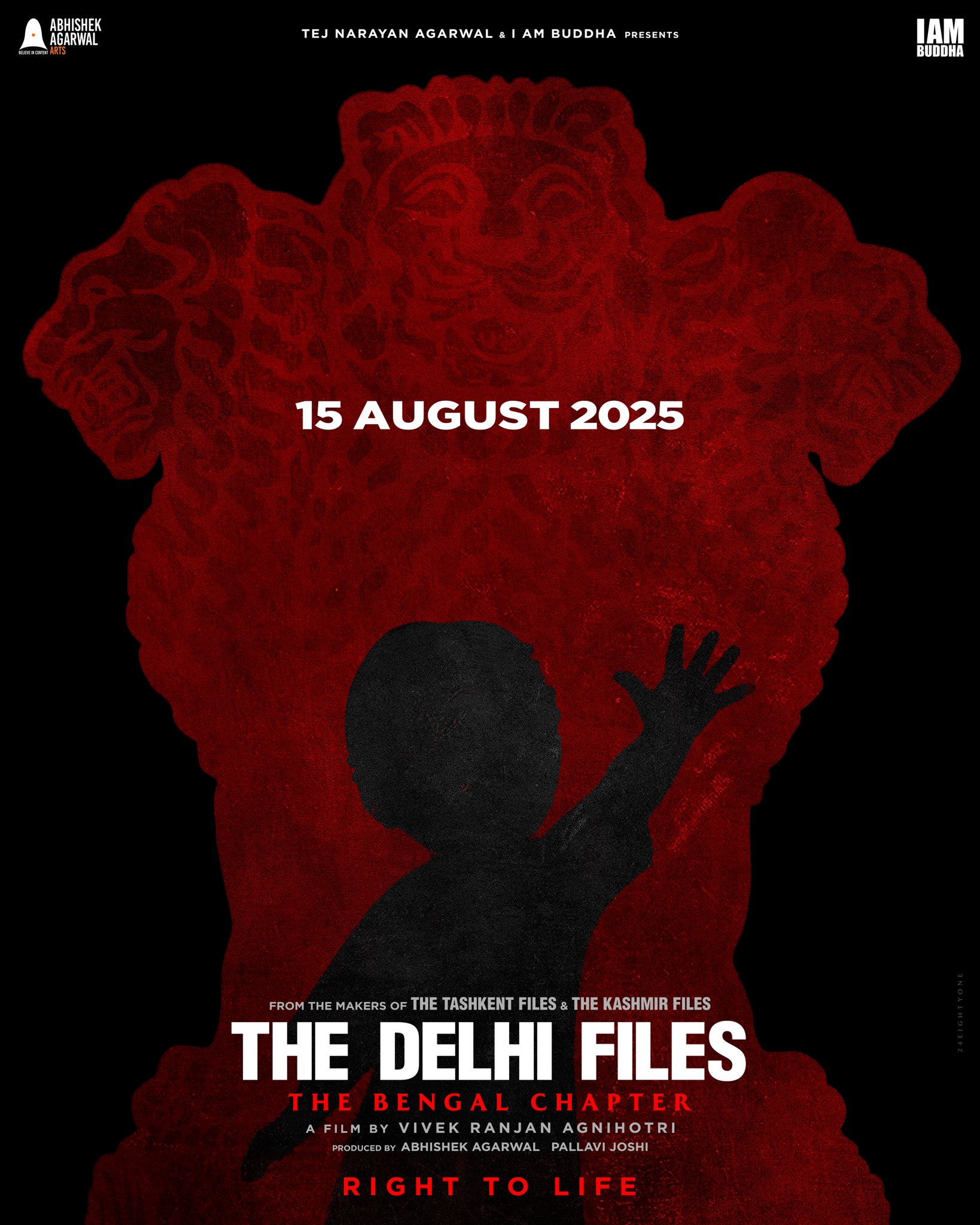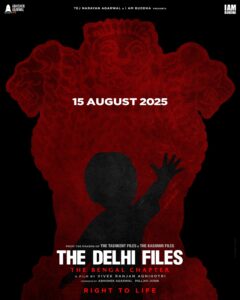
The Delhi Files: Why Vivek Agnihotri’s Final Installment in the “Files Trilogy” is a Must-Watch Historical Revelation
When we shot #TheDelhiFiles: Bengal Chapter last year, we had no idea it would become reality so soon.
Save Bengal from becoming another Kashmir. pic.twitter.com/lEjFVdbbdh
— Vivek Ranjan Agnihotri (@vivekagnihotri) April 22, 2025
Introduction: The Power of Truth-Based Cinema
In an era where mainstream cinema often prioritizes entertainment over education, Vivek Agnihotri has emerged as a filmmaker unafraid to challenge historical narratives. His upcoming film, The Delhi Files (2025), is the final chapter in his groundbreaking “Files Trilogy”, following The Tashkent Files (2019) and The Kashmir Files (2022).
This film, despite its title, delves into the forgotten horrors of the 1946 Bengal genocide, particularly the Direct Action Day massacres and Noakhali riots—events that reshaped India’s path to Partition.
But why is The Delhi Files such an important film? How does it connect to Agnihotri’s larger mission of exposing suppressed truths? And what impact will it have on India’s socio-political discourse?
This in-depth analysis explores:
-
The Evolution of the “Files Trilogy”
-
The Hidden History Behind The Delhi Files
-
Why This Film Matters Today
-
Controversies and Expected Backlash
-
How Vivek Agnihotri is Changing Indian Cinema
1. The “Files Trilogy”: A Cinematic Movement for Historical Truth
A. The Tashkent Files (2019) – Unmasking Political Conspiracies
-
Plot: Investigates the mysterious death of PM Lal Bahadur Shastri in Tashkent (1966).
-
Style: A political thriller blending real documents, witness testimonies, and conspiracy theories.
-
Impact:
-
Revived debates on political assassinations in India.
-
Won National Film Awards for Best Supporting Actress (Pallavi Joshi) and Best Dialogues.
-
Proved that audiences crave fact-based storytelling.
-
B. The Kashmir Files (2022) – The Genocide No One Talked About
-
Plot: Chronicles the 1990 exodus of Kashmiri Pandits, a tragedy ignored for decades.
-
Style: A raw, emotional narrative based on 700+ survivor interviews.
-
Impact:
-
Became a cultural phenomenon, earning ₹340 crore despite minimal marketing.
-
Declared tax-free in multiple BJP-ruled states.
-
Triggered nationwide debates on historical justice and minority rights.
-
C. The Delhi Files (2025) – Completing the Trilogy with Bengal’s Untold Tragedy
-
Plot: Explores the 1946 Calcutta Killings & Noakhali riots, where thousands of Hindus were massacred.
-
Style: Expected to blend historical reenactments with real survivor accounts.
-
Why It’s the Perfect Finale:
-
Connects pre-Partition violence to modern political narratives.
-
Challenges the “selective amnesia” around Bengal’s history.
-
2. The Suppressed History Behind The Delhi Files
A. Direct Action Day (August 16, 1946) – The Calcutta Killings
-
What Happened?
-
The Muslim League, led by M.A. Jinnah, called for “Direct Action Day” to demand Pakistan.
-
Resulted in 4,000–10,000 deaths (mostly Hindus) in 72 hours of carnage.
-
Streets of Calcutta turned into killing fields, with mobs slaughtering civilians.
-
-
Why Was It Forgotten?
-
Overshadowed by Punjab’s Partition violence.
-
British colonial records downplayed the massacre.
-
Post-Independence governments avoided uncomfortable truths.
-
B. The Noakhali Riots (October–November 1946) – A Forgotten Genocide
-
What Happened?
-
Muslim mobs targeted Hindus in Noakhali (now Bangladesh).
-
Mass murders, forced conversions, and sexual violence were rampant.
-
Gandhi’s visit to Noakhali highlighted the horror but failed to bring justice.
-
-
Why Does It Matter Today?
-
Shows how communal politics led to Partition.
-
Explains why Bengal’s Hindu population declined sharply post-1947.
-
#TheDelhiFiles: Bengal Chapter. Coming Soon.
This photo is from the edit room.
The scene was written a year ago and filmed last November.
I never imagined it would mirror reality so soon.#TheDelhiFiles is set to uncover truths long buried—past, and present. GET READY. pic.twitter.com/IXlwZxEtq9— Vivek Ranjan Agnihotri (@vivekagnihotri) April 14, 2025
3. Why The Delhi Files is More Relevant Than Ever
A. Correcting Historical Distortions
1. The Erasure of 1946 from Public Memory
One of the most disturbing aspects of modern Indian historiography is the deliberate omission of the 1946 Calcutta Killings and Noakhali riots from mainstream discourse. While school textbooks extensively cover the Partition of Punjab, the genocidal violence in Bengal is often reduced to a footnote, if mentioned at all.
-
Selective Historical Narratives:
-
The Congress-led governments post-Independence avoided addressing Bengal’s communal violence to maintain a secular image.
-
Marxist historians, dominant in academia, downplayed Hindu suffering while emphasizing communal harmony narratives.
-
The British colonial records, too, underreported casualties, focusing instead on political negotiations.
-
-
How The Delhi Files Will Change This:
-
By cinematically documenting survivor testimonies, the film will force historians to revisit suppressed archives.
-
It will challenge the “both sides suffered equally” narrative by exposing the targeted nature of the massacres.
-
Could lead to curriculum reforms, demanding accurate representation in textbooks.
-
2. The Distortion of Partition History
The popular narrative of Partition often centers on Punjab’s tragedy, while Bengal’s horrors remain sidelined.
-
Why This Matters:
-
The Direct Action Day riots (1946) were a precursor to Partition, proving that Jinnah’s call for Pakistan was backed by mass violence.
-
The Noakhali riots saw systematic ethnic cleansing, including forced conversions and sexual violence—a pattern later seen in Kashmir (1990).
-
By ignoring Bengal’s tragedy, we fail to learn from history, allowing communal tensions to persist.
-
-
The Film’s Role:
-
The Delhi Files will reconstruct the timeline of pre-Partition violence, proving that Muslim League’s politics directly led to genocide.
-
It will debunk myths, such as the claim that “Hindus and Muslims lived peacefully until British interference.”
-
B. Political Parallels to Modern India
1. The Rise of Identity Politics
The 1946 riots were fueled by communal polarization—similar to today’s political climate.
-
Parallels to Present-Day India:
-
Vote Bank Politics: Just as the Muslim League used religious mobilization in 1946, modern parties exploit caste and religion for electoral gains.
-
Selective Outrage: Media and activists today ignore Hindu persecution in Bengal, Bangladesh, and Pakistan, just as they did in 1946.
-
Radicalization: The same extremist ideologies that led to Direct Action Day are now visible in urban lynching cases and hate speeches.
-
-
How the Film Connects Past to Present:
-
By showing how unchecked communalism leads to violence, it serves as a warning for modern India.
-
Could spark debates on whether India is repeating the mistakes of 1946.
-
2. Bengal’s Growing Polarization
West Bengal has seen rising Hindu-Muslim tensions in recent years, making The Delhi Files alarmingly relevant.
-
Recent Incidents:
-
Post-2021 election violence: Reports of targeted attacks on Hindu households.
-
Illegal immigration: Changing demographics in border districts, leading to cultural clashes.
-
Radicalization cases: Increasing arrests of jihadi modules in Bengal.
-
-
Why the Film Could Be a Turning Point:
-
It will remind Bengalis of their own history of communal violence, urging caution.
-
May influence political discourse, especially before elections.
-
Could lead to demands for justice for 1946 victims, similar to Kashmiri Pandits.
-
C. Crowdsourced Research for Authenticity
1. Learning from The Kashmir Files Model
Agnihotri’s crowdsourcing approach ensures that the film is rooted in facts, not fiction.
-
How It Works:
-
Survivors and historians submit first-hand accounts, documents, and photographs.
-
The team cross-verifies details to avoid propaganda accusations.
-
Creates a public archive of otherwise forgotten history.
-
-
Impact of This Method:
-
Builds credibility: Unlike typical “based on true events” films, this relies on verified evidence.
-
Empowers victims: Gives a platform to those silenced for decades.
-
Sets a precedent: Encourages other filmmakers to adopt factual storytelling.
-
2. Ensuring the Film Isn’t Dismissed as “Propaganda”
Critics will inevitably label The Delhi Files as “Hindutva-driven”, but Agnihotri’s research-heavy approach makes it harder to dismiss.
-
Strategies to Counter Bias Allegations:
-
Including Muslim testimonies: Showing that not all Muslims supported the violence.
-
Using British-era documents: Neutral sources add legitimacy.
-
Avoiding exaggerated claims: Sticking strictly to documented events.
-
-
Why This Matters:
-
The more fact-based the film is, the harder it becomes for left-liberal historians to discredit it.
-
Increases chances of global recognition, like The Kashmir Files receiving support from international human rights groups.
-
4. Controversies & Expected Backlash
A. Accusations of “Propaganda” – The Inevitable Label
1. Why Critics Will Call It “Hindutva-Driven”
Vivek Agnihotri’s films have consistently faced accusations of promoting a right-wing narrative, and The Delhi Files will be no exception.
-
Past Precedents:
-
The Kashmir Files was dismissed by some as “Hindu victimhood propaganda”, despite being based on verified survivor accounts.
-
The Tashkent Files was criticized for “fueling conspiracy theories” about Shastri’s death.
-
-
Why This Happens:
-
Media Bias: Mainstream outlets often downplay Hindu persecution narratives, fearing backlash from secular lobbies.
-
Political Agenda: Left-liberal historians have long controlled India’s historical discourse, resisting any challenge to their version of events.
-
Selective Outrage: Films on Islamic extremism (e.g., The Kerala Story) face harsher scrutiny than those on other themes.
-

2. How Agnihotri’s Films Defy the “Propaganda” Tag
Despite accusations, Agnihotri’s films stand out because:
-
They rely on documented evidence (archives, survivor testimonies, declassified reports).
-
They expose events ignored by mainstream media (e.g., the exodus of Kashmiri Pandits).
-
They provoke debate rather than suppress it—unlike films that whitewash history.
Will The Delhi Files overcome these accusations?
-
If the film sticks to verifiable facts (like British-era documents on the 1946 riots), critics will struggle to dismiss it entirely.
-
However, expect Twitter hashtags like #BoycottDelhiFiles and opinion pieces calling it “divisive”.
B. International Censorship Battles – Will the Film Be Banned?
1. Lessons from The Kashmir Files
Agnihotri’s previous film faced bans and restrictions abroad, suggesting The Delhi Files might encounter similar hurdles.
-
Singapore: Banned The Kashmir Files, citing risks to “religious harmony”.
-
New Zealand & Australia: Initially rated it R18 (restricted), fearing “Islamophobic backlash”.
-
Middle East: No official release in Gulf countries, likely due to political sensitivities.
2. Where The Delhi Files Could Face Censorship
-
Singapore: Likely to ban it again, given its strict laws on “inflammatory content”.
-
UK & Canada: May allow release but with disclaimers (e.g., “This film depicts contested historical events”).
-
Bangladesh: Almost certainly banned, as it covers Noakhali (now part of Bangladesh) in a negative light.
-
Film Festivals: Might be rejected by liberal-leaning festivals (like Cannes or Berlinale) over “political controversy”.
3. Will the Indian Government Intervene?
-
BJP Support: The ruling party may push for international screenings, just as it did for The Kashmir Files.
-
Opposition Pressure: Parties like TMC could lobby foreign governments to restrict the film.
Prediction: The Delhi Files will have a tougher global journey than The Kashmir Files, given its focus on pre-Independence politics, which foreign censors may find “too sensitive”.
5. How Vivek Agnihotri is Revolutionizing Indian Cinema
-
From Entertainment to Education: Proves films can inform, not just entertain.
-
Crowdsourcing History: Involves the public in research and storytelling.
-
Box Office Success: Shows audiences want bold, unfiltered narratives.
Are you excited for #TheDelhiFiles? pic.twitter.com/2cFCr9XzjQ
— Kreately.in (@KreatelyMedia) May 17, 2025
Final Verdict: Will You Watch The Delhi Files?
As The Delhi Files prepares for its Independence Day 2025 release, it stands at the crossroads of art, history, and politics—promising to be far more than just another Bollywood production. This film represents a cultural moment, one that will force audiences to confront uncomfortable truths about India’s past while sparking fierce debates about its present and future.
Why This Film Demands Your Attention
1. A Cinematic Experience Unlike Any Other
Unlike typical historical dramas that gloss over painful truths, The Delhi Files promises:
-
Unflinching realism in depicting the 1946 massacres
-
Never-before-seen archival footage of the Calcutta killings
-
Emotionally raw performances from a stellar cast including Mithun Chakraborty and Anupam Kher
2. A Test of India’s Intellectual Honesty
This film will serve as a litmus test for how India engages with its own history:
-
Will audiences seek truth even when it’s uncomfortable?
-
Will intellectuals dismiss it as propaganda without fair examination?
-
Can we separate historical facts from political interpretations?
3. Potential to Reshape National Discourse
Just as The Kashmir Files changed how India discussed Kashmiri Pandits, this film could:
-
Force textbooks to rewrite the history of Partition
-
Bring justice to forgotten victims’ families
-
Inspire new research into suppressed historical events
Who Should Watch This Film?
1. History Enthusiasts
If you care about India’s true historical narrative, this is essential viewing.
2. Social Commentators & Politicians
The film’s reception will reveal much about India’s current political climate.
3. Every Concerned Indian Citizen
In an era of fake news and historical revisionism, this film offers a rare truth-seeking perspective.
AFTER ‘THE KASHMIR FILES’, VIVEK AGNIHOTRI – ABHISHEK AGARWAL TEAM UP FOR ‘THE DELHI FILES’: FIRST GLIMPSE OUT NOW… INDEPENDENCE DAY 2025 RELEASE… On the occasion of #RepublicDay, here’s the first glimpse from director #VivekRanjanAgnihotri‘s #TheDelhiFiles:… pic.twitter.com/PnIjF6VHYg
— taran adarsh (@taran_adarsh) January 26, 2025
The Bigger Question: What Happens After You Watch?
This isn’t just about entertainment—it’s about what you do with the knowledge:
-
Will you share these stories with younger generations?
-
Will you question mainstream narratives you’ve been taught?
-
Will you demand more truthful storytelling in Indian cinema?
film will force India to confront its darkest, most suppressed history.



